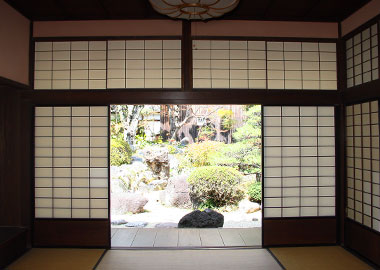|
||
 |
||

Old Sugiyama 杉山 house (Osaka)
(C)2001 Japanese Architecture and Art Net Users System. No reproduction or republication without written permission.
掲載のテキスト・写真・イラストなど、全てのコンテンツの無断複製・転載を禁じます。
|
||||||
| akarishouji 明障子 | ||||||
| KEY WORD : architecture / general terms | ||||||
| One type of *shouji 障子. A translucent screen or sliding door made by pasting single sheets of white Japanese paper *washi 和紙 on light wooden frames, or sometimes on bamboo frames. Fine, gauze-like silk cloth is occasionally used instead of paper. Size and style vary according to use. Akarishouji that has a lattice wainscot is called koshishouji 腰障子. It varies from 30cm to 60cm in height. Usually it is backed by a board, but sometimes straw matting or cypress bark is used. If the wainscot is higher than 60cm, it is called *koshidaka shouji 腰高障子. Sudareshouji 簾障子 are like akarishouji because light can pass through them, but instead of paper or silk, ditch reed, cat tail stalk, or pampas grass is used and held together by interwoven cord, often in a double row on each side from top to bottom. This allows soft light and air to enter. These are also called summer shouji *natsushouji 夏障子. It is not exactly clear when akarishouji were first used. However, a similar term, written あかり志やうし (read akarishiyaushi), is found in the 1522 record of folk dwellings, YURI MONJO 百合文書, belonging to Kyouougokokuji 教王護国寺 in Kyoto, and this may refer to akarishouji. | ||||||
 Old Sugiyama 杉山 house (Osaka)
|
||||||
| REFERENCES: | ||||||
| EXTERNAL LINKS: | ||||||
| NOTES: | ||||||
(C)2001 Japanese Architecture and Art Net Users System. No reproduction or republication without written permission. 掲載のテキスト・写真・イラストなど、全てのコンテンツの無断複製・転載を禁じます。 |
||||||